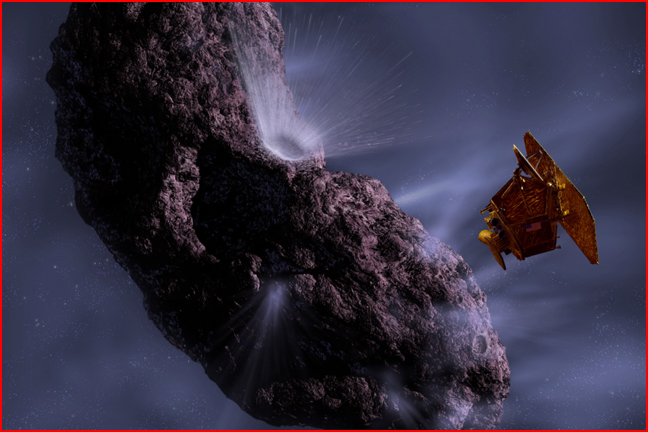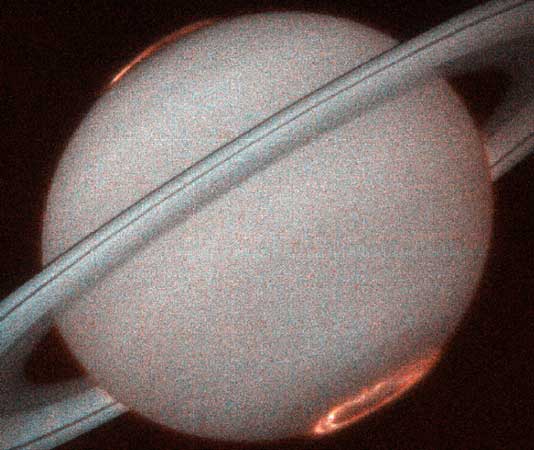|
THUNDERBOLTS PICTURE OF THE DAY
|
||
 Credit: NASA/JPL/UMD Artwork by Pat Rawlings |
||
|
Electric Universe: Society for
|
Jul 04, 2005 With the imminent arrival of the "Deep Impact" spacecraft at the comet Tempel 1, it is time to test competing theories on the nature of comets. The predictions and lines of reasoning offered here will set the stage for future analysis of the "electric comet" model. We are posting this document at 1:45 a.m. Sunday, July 3, with "Deep Impact" less than 24 hours away. This Picture of the Day will remain through July 4. It will be followed within 48 hours (or less) by another Picture of the Day with a preliminary evaluation of the event. At 10:52 p.m. PDT July 2, the Deep Impact spacecraft will fire an 800-pound copper projectile at the nucleus of Comet Tempel 1. If all goes as planned the projectile will impact on the nucleus 24 hours later. The impact is expected to eject into space large volumes of subsurface material. Cameras on the projectile will record its approach toward the nucleus, and instruments on the spacecraft will record the event across a broad spectrum. Dozens of telescopes will be trained on the comet. According to NASA scientists, the released material will provide a sample of the primordial water, gas and dust from which the Sun, planets, moons, and other bodies in the solar system formed. Though Deep Impact team members see this as a milestone event, advocates of the Electric Universe expect a "shock to the system" with revolutionary implications. They say that a comet is not a primordial object left over from the formation of the solar system. Fundamentally, it is distinguishable from a rocky asteroid only by its more elliptical orbit. In the Electric Universe a comet is a negatively charged object moving through the extensive and constant radial electric field of the positively charged Sun. A comet becomes negatively charged during its long sojourn in the outer solar system. As it speeds into the inner solar system, the increasing voltage and charge density of the plasma (solar "wind") cause the nucleus to discharge electrically, producing the bright coma and tail. If the electrical theorists are correct, the implications of the event will not be limited to comet theory alone. At issue is the assumption of an electrically neutral universe, upon which every conventional astronomical theory rests. An electric comet would forever change the picture of the solar system and force astronomers to consider the overwhelming evidence that electricity lights not only our Sun but also all the stars in the heavens. Moreover, the cosmic electricians insist that this would only be the beginning of a more sweeping revolution touching all of the theoretical sciences and in the end recasting our understanding of earth history and the human past. The most appropriate test of a new theory is its predictive power (see predictions from October 2001 in Wallace Thornhill's "Comet Borrelly Rocks Core Scientific Beliefs"). Therefore, we wish to make as clear as possible, in advance of the projectile's impact, the distinctions between the electric model and the standard model. Where the issues grow complex, the primary reason is that the standard model, which failed to anticipate any of the major discoveries about comets over the past three decades or more, has fragmented into competing versions, forced upon the theorists by unsettling facts. Nevertheless a shared ideology continues to guide orthodox comet investigation while limiting scientific perception. For this reason advocates of the electric universe do not believe that a reconciliation of the current theoretical fragments is possible. To facilitate clarity we shall offer first a brief outline of two theoretical models. As for predictions, we find that NASA scientists have retreated from such essential adventures. Therefore we shall not attempt to speak for them. But we will summarize the best guesses of the electrical theorists. DIRTY SNOWBALL MODEL
ELECTRIC COMET MODEL:
ELECTRIC MODEL PREDICTIONS FOR DEEP IMPACT:
We include below a summary of the lines of reasoning followed by the electrical theorists. MISSING WATER For the survival of the standard model, nothing is more crucial than finding an abundance of ices on or below the surface of the nucleus of Tempel 1. It is not sufficient to find water merely in the comet's coma. Negative oxygen ions from cathodic etching of rock minerals in the nucleus will combine with protons from the solar wind to form water in the coma and tail. Spectra of comets already reveal the presence of negative oxygen ions. Moreover, the ions exhibit forbidden lines characteristic of a strong electric field. There is no conventional explanation for these observations. Wallace Thornhill, whose inquiry into the electric attributes of comets goes back more than 30 years, sees a high probability that scientists will find less water ice and other volatiles than expected, both on the surface and beneath the surface of Tempel 1. In fact none of the electrical theorists will be surprised if the impactor exposes a subsurface with little or no ices. For popular comet theory this would be disastrous, since it now calls upon volatile ices beneath the surface to drive the comet's jets and create the glowing coma. This requirement is due to the surprising discovery, through prior comet probes, of dry surfaces. The surface of Comet Borrelly, for example, was parched. But the problem for comet theory is more severe, since evidence for subsurface volatiles also ranges from minimal to non-existent. Examination of Shoemaker-Levy 9 after the comet broke apart revealed no volatiles. When comet Linear disintegrated in front of their eyes, astronomers were astonished by the absence of meaningful water content. Comets do not "disintegrate" by solar heating but explode electrically like an overstressed capacitor. Of course there are plenty of icy moons in the solar system, and the electrical theorists propose that many comets and asteroids are part of the "afterbirth" of electrical expulsion of planets and moons from their parent primary. So they do not exclude in advance the possibility of water ice on Tempel 1. But it is not required in the electrical model of comets for the production of jets, comas and tails. SHARP SURFACE RELIEF The electric model claims that the comas and tails of comets are generated by cathode arcs excavating surface material from the nucleus, in the fashion of electrical discharge machining (EDM) in industrial applications. The model predicts a sculpted surface, distinguished by sharply defined craters, valleys, mesas, and ridges -- the opposite of the softened relief expected of a sublimating "dirty snowball". (A chunk of ice melting in the Sun loses its sharp relief, just like a scoop of melting ice cream.) BLACK SURFACES The first photographs of comet nuclei astonished astronomers with the blackness of the surfaces. The nuclei were darker than copier toner. This observation alone should have called into question the "dirty snowball" hypothesis. But an ad hoc adjustment of the theory followed, arbitrarily assuming that comets were parked for billions of years in deep space, where they suffered radiation damage that blackened their surfaces. Electric discharge machining "burns" and darkens the rocky comet surface. It requires no additional hypotheses or contrived history of the comet. We see examples of the darkening effect from electrical discharge on Jupiter's moon Io and on the planet Mars. WEAKLY CHARGED COMETS. Comet Tempel 1, which NASA selected for the Deep Impact mission, is certainly not ideal for testing the electrical hypothesis. Of course, NASA scientists do not realize this, since the issue of electrical charge has no place in standard theory. Short-period comets, which move on modestly elliptical paths (the orbit of Tempel 1 stretches roughly between the orbits of Jupiter and Mars) will not experience the degree of electrical imbalance experienced by long-period comets on much more elliptical paths that take them out well beyond the orbital distances of Neptune or Pluto. The latter have much more time to adjust to the more negative voltage of regions remote from the Sun. The voltage difference of short-period comets as they approach the Sun will be much less than that of long-period comets, and they will not discharge as energetically. Nevertheless, the electrical theorists say that even a weak candidate for a test of the electrical hypothesis should be sufficient to make a good case. The radical differences between the competing models carry many direct and obvious implications. ANOMALOUS X-RAYS If (and it's the biggest "if") Tempel 1 is sufficiently electrically active before impact, Thornhill expects to see the usual non-linear behavior of plasma when subjected to increasing electrical stress. That is, there will be a sudden electric discharge, or arc. An electric discharge between the comet cathode and the copper projectile anode will result in X-ray emission, just as in any X-ray machine on Earth. Such X-rays are easily identifiable and in large amounts would be anomalous for a mere impact. The electric field of a comet is contained within its (Langmuir) plasma sheath, which encompasses its coma. So the size of the coma is some measure of the electrical stress the comet is suffering. Comet Tempel 1 has a small coma. Two months ago the coma was little bigger than the Earth. However, the comet is rushing toward the copper projectile at almost 23,000 mph, which will not give time for the copper projectile in the exceedingly thin cometary plasma to balance its electrical potential with that of the more negative comet nucleus. So,before physical impact occurs, we may expect a sudden discharge between the comet nucleus and the copper projectile. It will have the characteristic light-curve of lightning, with rapid onset and exponential decay. The question is, will it be a mere spark or a powerful arc? Whether due to impact or electric arc, positively charged copper ions may be expected to produce radiation by recombination with free electrons. A small proportion of that radiation may be in the x-ray region. But the spectrum and intensity curve for radiation from an impact should be quite different from the flash of an electric arc impinging on a copper anode. The arc should also give a restricted, almost point, source for the radiation from the target sites on the impactor and the comet nucleus. This is quite different from anything expected from distributed explosion products. Because electric arcing causes the craters seen on comets, there is the possibility that the Deep Impact projectile will form an electrical crater as well as (or instead of) an impact crater. When the impactor arrives, Thornhill considers it likely that active jets will move or switch off, since the comet's electrical field will have been suddenly disturbed. The simple thermal out-gassing model does not expect this. ANOMALOUS DISCHARGE Outbursts from comet nuclei frequently occur, giving rise to expressions of astonishment from comet observers. Such events do not fit well with a model of sublimating ices, and the cause remains mysterious. But such events have required cometologists to speculate about heating processes inside the comet. In the electrical model, energetic outbursts are expected due to the non-linear behavior of plasma in the changing electrical environment of the solar "wind". Comets have flared beyond the orbit of Jupiter, even beyond the orbit of Saturn, where known icy bodies do not sublimate under solar radiation. A potentially embarrassing, ad hoc proposal has been put forward that attributes the more remote and "miraculous" outbursts to collisions with meteoric material. In fact, all energetic discharging from comet nuclei at the distance of Mars' orbit or beyond is anomalous under the standard model. Attempts at explanations invariably expose contradictions. We see ice on Mars and on the moons of the gas-giant outer planets. Mars, of course, is the closest of the three to the Sun, but when ice sublimates on Mars, it does not produce jets. The icy moons of Jupiter do not produce jets under the influence of solar radiation. Here, the electrical theorists can only express their amazement at the general lack of attention to such contradictions when comets begin discharging even farther out from the Sun. COLLIMATED AND FILAMENTARY JETS Despite years of photographs showing collimated jets (narrow filaments that maintain their coherence across considerable distances), the artists' conceptions of comets still show jets as geyser-like eruptions, spraying out into space. An expanding jet is the expected behavior of neutral gas and dust entering a vacuum. But it is not characteristic of an electric discharge in plasma. A good look at the jets of Tempel 1 reveals the characteristic features of a plasma discharge, with coherent current filaments that do not obey the rules of behavior of neutral gases. A look at a novelty-store plasma ball demonstrates the effect nicely. JET ENERGIES AND VELOCITIES On this issue the electrical theorists are emphatic: by proposing mechanical "jets" from comet nuclei, standard theory has descended into the preposterous. No analogy either in space or in experimental science supports the idea that sublimating ices 150 million miles and farther from the Sun could generate "jet chambers" or produce the sonic and supersonic jet velocities our instruments have measured. The notion is inherently contradictory and violates the most obvious dynamic principles. Collimated, mechanically induced jets over the observed distances they travel would require, first, a finely machined nozzle, even more precise than those used on rocket engines, not a jagged opening in a "dirty snowball. The idea requires a chamber that is insulated from the Sun, though anything even casting a shadow would lead to instant freezing. The "model" also requires subsurface heating in the deep freeze of these remote regions. The "heating" would have to reach through an insulating crust roughly estimated to be ten feet deep, yet achieving things inconceivable for solar heating even in the absence of insulation. Pressure must build up to an extraordinary level. Then when the pressure erupts, something most mysterious must occur. Despite the instant release, equivalent pressures must be sustained for long periods to maintain the supersonic velocities -- even to alter the orbits of comets in the way some astronomers now propose. We've said it before: "To save the theory astronomers now cling to the incredible". For the electrical theorists, the answer is all too obvious. Electrical discharge accelerates material into collimated jets along the self-confining Birkeland currents that constitute the discharge arcs. HEAVY ELEMENTS If an arc is struck between the comet nucleus and the projectile, we may expect to see metals such as Li, Na, K, Ca, Mg and Fe in a flash spectrum before impact. They will have been removed from the rocky comet in the cathode arc. The sulfur molecule S2 is one of the great unsolved mysteries of comet chemistry. It has been identified in several, but not all, comets. The molecule has a very short lifetime and sublimes at a higher temperature than those found on cometary surfaces or grains. It is not the equilibrium form of the molecule either. But S2 is the kind of molecule that could be produced from rocky minerals in the extreme electrical environment of a plasma arc. NEGATIVE IONS Negative ions were discovered in the inner coma of Comet Halley with densities 100 times greater than expected from conventional theory. Thornhill and his colleagues urge NASA investigators to look for an abundance of negative ions in the impact ejecta. This would, of course, be an obvious signature of a negatively charged comet. Forbidden spectral lines from negative oxygen ions have been detected spectroscopically in comet comas in the past. And no one can reasonably dispute that they indicate the presence there of a strong electric field. It is advisable that investigators look at water abundances both close to the nucleus and in the far coma to see to what extent water is being formed away from the nucleus by the combination of negative oxygen ions with protons from the solar wind. The logical concern here is that these reactions will, by improper reasoning, give inflated values for the water ice abundance in the comet nucleus. IMPACTOR LIGHTNING STRIKE The copper impactor has a camera that is supposed to be active until impact. There is some doubt that the camera will be able to provide images closer than a few tens of kilometers to the nucleus because of anticipated damage to the lens by high-velocity dust particles. However, transmissions should continue until impact, according to NASA investigators. But if an arc to the projectile occurs, transmissions will cease before impact. Of course, the most tragic potential here is that the projectile, which carries its own navigation instruments, could experience an electrical disruption before it had maneuvered itself into the precise position required for impact. IMPACT SITE TEMPERATURES A mechanical impact will not produce the temperatures of an electric arc, which can be tens of thousands of degrees over a very small area. The problem will be whether temperature readings will have the resolution to be able to distinguish a very high temperature over a tiny area or merely an average over a large impact area. Anomalous high temperature readings could precede physical impact, accompany impact, and follow impact. COMET BRIGHTNESS Tempel 1 is a magnitude dimmer than (i.e., less than half as bright as) expected from the comet's previous approaches to the Sun. Conventional theory has no explanation for this lower energy. The electrical model notes that the Sun is approaching the minimum in its sunspot cycle, which means that the solar electrical energy input is at a minimum. Because the comet's brightness depends on electrical energy from the Sun's circuit, the effect is analogous to turning down the dimmer switch on a light bulb. This lower energy level also reduces the likelihood of the more dramatic "electrical fireworks" during Deep Impact's encounter. See also: |
|
|
Copyright 2005: thunderbolts.info
|
||

